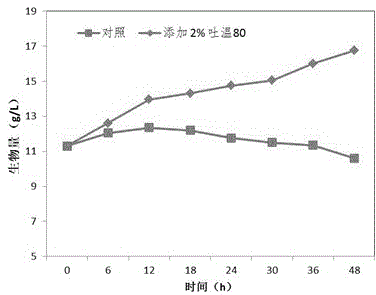A method of efficiently catalyzing dehydroepiandrosterone by utilization of a resting cell of colletotrichum linli
A technology of C. flaxensis and dehydroepiandrosterone, which is applied in the field of high-efficiency catalysis of dehydroepiandrosterone, to achieve the effects of improving utilization rate, increasing product yield, and facilitating separation and extraction
- Summary
- Abstract
- Description
- Claims
- Application Information
AI Technical Summary
Problems solved by technology
Method used
Image
Examples
Embodiment 1
[0022] Embodiment 1 Craniospora flax ( Colletotrichum linli )ST-1 Transformation of Growing Cells vs Transformation of Resting Cells
[0023] (1) Preparation of liquid cell culture of C. flaxensis
[0024] Pick an appropriate amount of spiny sporospora mycelium from the slant medium, inoculate it into a 250 mL Erlenmeyer flask filled with 30 mL of seed medium, and culture it on a shaker at 220 r / min for 72 h at 30 °C Perform activation, and then inoculate the primary seeds with (8%-10% V / V) inoculum into a new seed medium (in a 500 mL Erlenmeyer flask containing 100 mL of seed medium) and proceed with the shaker conditions above After expansion and cultivation for 24 h, a considerable concentration of cell liquid culture was obtained.
[0025] (2) Preparation of resting cell suspension of C. flaxensis
[0026] Inject the cell liquid culture prepared in step (1) into the fermentation medium with an inoculum size of 10 % (w / w), with a liquid volume of 100 mL / 500 mL, and cult...
Embodiment 2
[0033] Embodiment 2 pH is to flax sporophyllum ( Colletotrichum linli ) ST-1 Effects of Resting Cell Transformation
[0034] (1) Preparation of liquid cell culture of C. flaxensis
[0035] Same as (1) in Example 1
[0036] (2) Preparation of resting cell suspension of C. flaxensis
[0037] Inject the liquid cell culture prepared in step (1) into the fermentation medium with an inoculum size of 8-10% (w / w), with a liquid volume of 100 mL / 500 mL, at 30°C, at a speed of 220 r / min Cultivate at low temperature for 24 h, collect the cells by centrifugation, wash the cells twice with 0.01M sodium phosphate buffer at pH 7.0 (remove the remaining components in the fermentation broth), collect the cells, and suspend them in pH 5.5 / 6.5 / In 7.5 sodium phosphate buffer, the buffer concentration is 0.2M, and a resting cell suspension with a cell concentration of 10-12 g / L is prepared for use in transformation.
[0038] (3) Transformation of resting cells
[0039] Take 30 mL of the...
Embodiment 3
[0042] The concentration of embodiment 3 buffering solution is to the flax sporophyllum ( Colletotrichum linli ) ST-1 Effects of Resting Cell Transformation
[0043] (1) Preparation of liquid cell culture of C. flaxensis
[0044] Same as (1) in Example 1
[0045] (2) Preparation of resting cell suspension of C. flaxensis
[0046] Inject the liquid cell culture prepared in step (1) into the fermentation medium with an inoculum size of 8-10% (w / w), with a liquid volume of 100 mL / 500 mL, at 30°C, at a speed of 220 r / min Cultivate at low temperature for 24 h, collect the cells by centrifugation, wash the cells twice with 0.01M sodium phosphate buffer at pH 7.0 (remove the remaining components in the fermentation broth), collect the cells, and suspend them in 0.02M / In 0.05M / 0.1M / 0.2M sodium phosphate buffer (both pH 6.5), prepare a resting cell suspension with a cell concentration of 10-12 g / L for transformation.
[0047] (3) Transformation of resting cells
[0048] Take 3...
PUM
 Login to View More
Login to View More Abstract
Description
Claims
Application Information
 Login to View More
Login to View More - R&D
- Intellectual Property
- Life Sciences
- Materials
- Tech Scout
- Unparalleled Data Quality
- Higher Quality Content
- 60% Fewer Hallucinations
Browse by: Latest US Patents, China's latest patents, Technical Efficacy Thesaurus, Application Domain, Technology Topic, Popular Technical Reports.
© 2025 PatSnap. All rights reserved.Legal|Privacy policy|Modern Slavery Act Transparency Statement|Sitemap|About US| Contact US: help@patsnap.com



